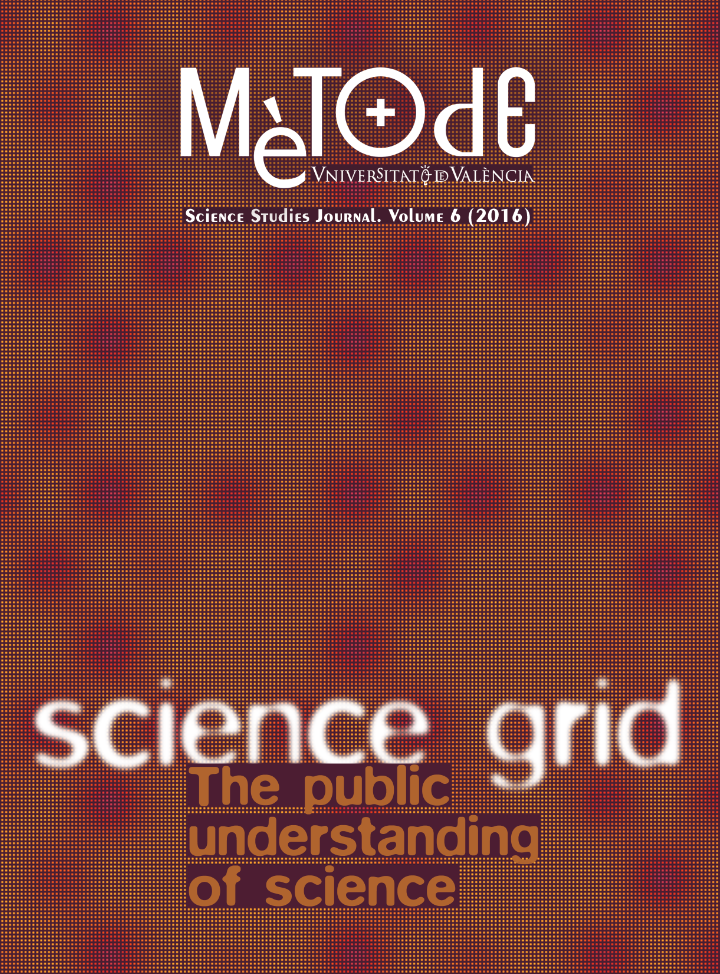Arguing to convince: The rhetoric of scientific discourse
DOI:
https://doi.org/10.7203/metode.6.4615Keywords:
rhetoric, rhetorical extension, rhetorical discourse, scientific discourse, argumentation Abstract
Abstract
This paper deals with scientific discourse as a rhetorical discourse from the point of view of the structure of the classical parts of oral discourse (and all kinds of discourse). The role of argumentation in discourse, with the perlocutionary goal of convincing the receiver, is studied as the foundation of the rhetorical nature of scientific discourse. A scientific treatise by Santiago Ramón y Cajal is analysed using the tools provided by rhetoric in order to prove the rhetorical nature of scientific discourse. The main contribution of this paper is to establish the crucial role of argumentation in scientific discourse and to demonstrate its permeation of the entire discourse.
 Downloads
Downloads
 References
References
Albaladejo, T. (1988-1989). Semántica y sintaxis del texto retórico: inventio, dispositio y partes orationis. Estudios de Lingüística Universidad de Alicante, 5, 9–15.
Albaladejo, T. (2013). Retórica cultural, lenguaje retórico y lenguaje literario. Tonos. Revista de Estudios Filológicos, 25. Retrieved from http://www.um.es/tonosdigital/znum25/secciones/estudios-03-retorica_cultural.htm
Arduini, S. (2007). Metaphors concepts cognition. In S. Arduini (Ed.), Metaphors (pp. 7–16). Rome: Edizioni di Storia e Letteratura.
Aristóteles. (1971). Retórica. Madrid: Instituto de Estudios Políticos. Chico Rico, F. (2015). La traducción del texto filosófico: Entre la literatura y la ciencia. Castilla. Estudios de Literatura, 6, 94–112. Retrieved from http://www5.uva.es/castilla/index.php/castilla/article/view/422
García Berrio, A. (1984). Retórica como ciencia de la expresividad. Presupuestos para una Retórica General. Estudios de Lingüística Universidad de Alicante, 2, 7–59.
Hernández Guerrero, J. A., & García Tejera, M. C. (2004). El arte de hablar. Manual de retórica práctica y de oratoria moderna. Barcelona: Ariel.
Lausberg, H. (1966-1968). Manual de retórica literaria. Fundamentos de una ciencia de la literatura. Madrid: Gredos.
Marraud, H. (2007). Methodus argumentandi. Madrid: Ediciones de la UAM.
Ordóñez, J. (1998). Sobre la persuasión en la ciencia: Cómo se puede explicar lo que se ve. Retórica hoy. Teoría/Crítica, 5, 281–292.
Pera, M. (1991). Scienza e retorica. Rome – Bari: Laterza.
Pujante, D. (2003). Manual de retórica. Madrid: Castalia.
Quintiliano, M. F. (1970). Institutio oratoria. Oxford: Oxford University Press.
Ramón y Cajal, S. (1921). Las sensaciones de las hormigas. Madrid: Real Sociedad Española de Historia Natural. Retrieved from http://cvc.cervantes.es/ciencia/cajal/cajal_articulos/hormigas.htm
Real Academia Española. (2014). Ciencia. In RAE (Ed.), Diccionario de la Lengua Española. Madrid: RAE – Espasa.
Salvador Liern, V. (2008). Applied rhetoric and stylistics in Spain and Portugal in the 20th and 21st centuries. In U. Fix, A. Gardt, & J. Knape (Eds.), Rhetorik und stilistik/rhetoric and stylistics. Ein internationales handbuch historischer und systematischer forschung. an international handbook of historical and systematic research (pp. 532–550). Berlin – New York: De Gruyter.
Zamora Bonilla, J. P. (2006). Rhetoric, induction, and the free speech dilemma. Philosophy of Science, 73, 175–193.
Downloads
Published
How to Cite
-
Abstract1625
-
PDF518
Issue
Section
License
![]()
All the documents in the OJS platform are open access and property of their respective authors.
Authors publishing in the journal agree to the following terms:
- Authors keep the rights and guarantee Metode Science Studies Journal the right to be the first publication of the document, licensed under a Creative Commons Attribution-NonCommercial-NoDerivatives 4.0 International License that allows others to share the work with an acknowledgement of authorship and publication in the journal.
- Authors are allowed and encouraged to spread their work through electronic means using personal or institutional websites (institutional open archives, personal websites or professional and academic networks profiles) once the text has been published.





